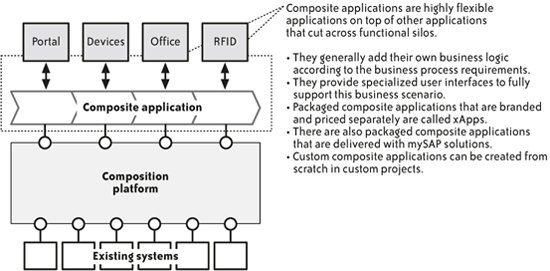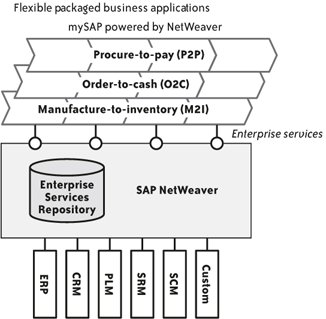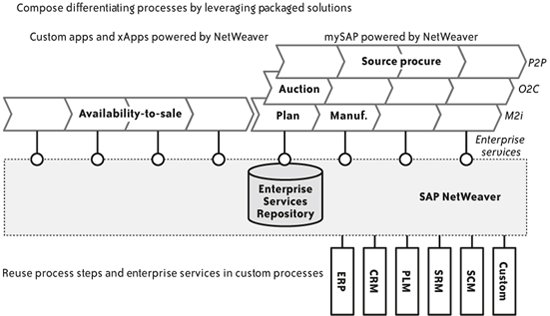Section 4.13. What are composite applications?
4.13. What are composite applications?Composite applications, illustrated in Figure 4-3, are applications built using services as building blocks. The word composite has two shades of meaning that make it easier to understand. As a noun, composite means something that is composed of many different things. For an application to be a composite, it means that it is assembled from many existing parts. This is in sharp contrast to applications that are built through so-called greenfield development in which the entire application is created from scratch. The idea of composite applications is that development is accelerated because existing services are used as a starting point and development of new functionality is kept to a minimum. Composite applications are about reuse. Another shade of meaning enters when we think of the verb composing. Composite applications are composed rather than developed. Composing means assembling all the required services and orchestrating them so that they work together to perform a new task. Composing frequently takes place through use of modeling rather than coding in traditional languages. Development of composite applications is accelerated in another way. Modeling and the use of services mean that the logic connecting the services is not nearly as complex as traditional applications and is clearly separated into layers. This makes adapting a composite to meet new purposes much easier and faster. So, what are composite applications about? Reuse, speed of development, and flexibility. Figures 4-4 and 4-5 depict an example of one such composition. They illustrate the composite applications now at work inside a manufacturer that decided to turn its supply chain and manufacturing processes inside out. Instead of thinking of new products, building them, selling them, and shipping them, this manufacturer decided to start with its suppliers first, asking them, "What can you sell me cheaply today?" The manufacturer runs the answers through its APO to compile a list of everything it can build with that day's grab bag of cheap components and then sends that list to all of its distributors, creating an auction in which the distributors bid to distribute and sell whatever the manufacturer built that day. When an order arrives through the auction system, the manufacturer goes back to its suppliers, orders the components it needs, manufactures the goods, and then checks to see what it no longer has the potential supplies to make, pulling those orders off the auction block. Figure 4-3. Defining composite applications Figure 4-4. A packaged business process The company runs this reverse-auction process using a composite solution assembled with pieces of functionality from its APO, CRM, and supplier relationship management (SRM) applications, including common business processes such as procure to pay, order to cash, and manufacture to inventory. The manufacturer just needed to wire them differently. Normally, however, it might take a company 12 months to figure out what it needs to change in its systems and another 18 months to change it. Figure 4-5. A custom business process created by leveraging packaged solutions |
EAN: 2147483647
Pages: 265